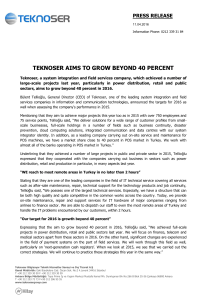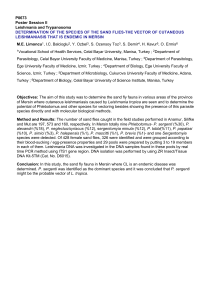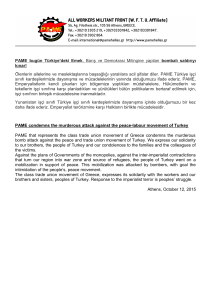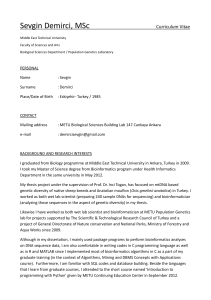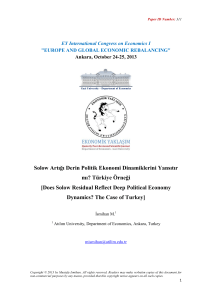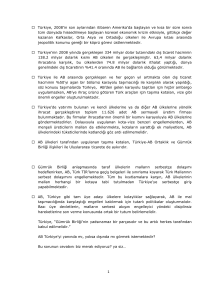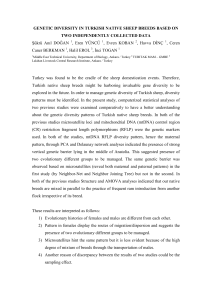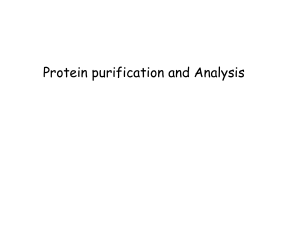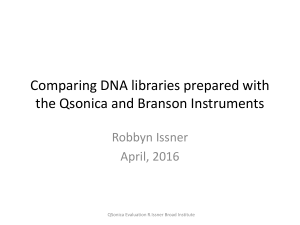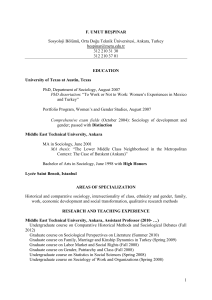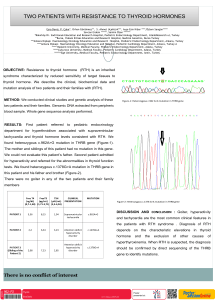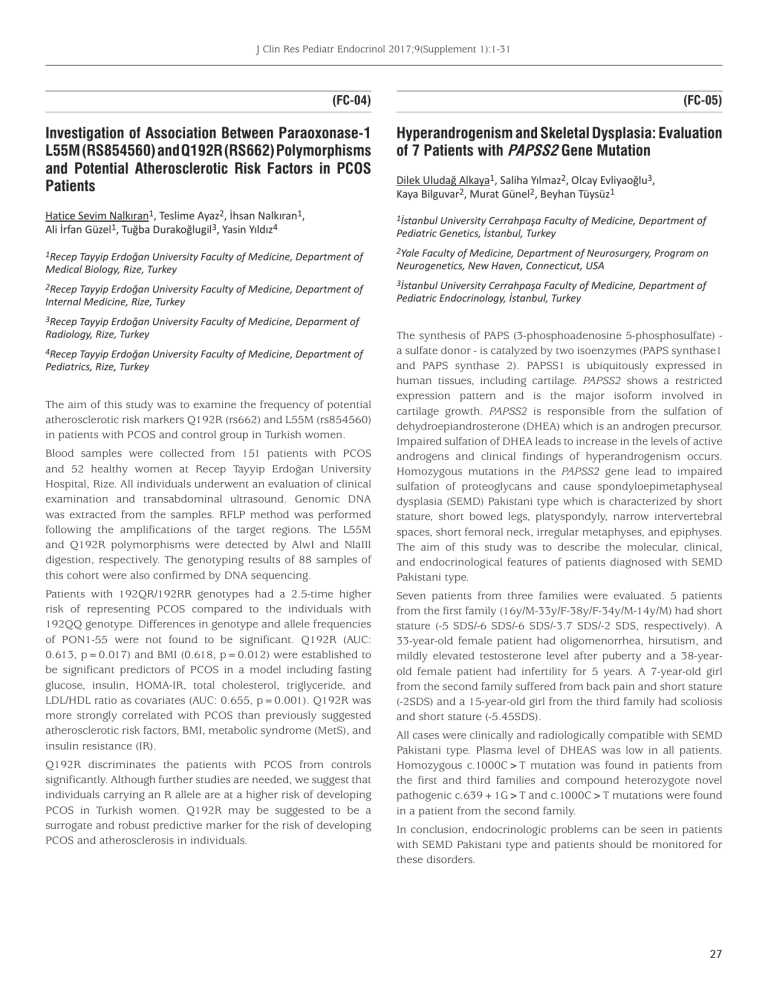
J Clin Res Pediatr Endocrinol 2017;9(Supplement 1):1-31
(FC-04)
(FC-05)
Investigation of Association Between Paraoxonase-1
L55M (RS854560) and Q192R (RS662) Polymorphisms
and Potential Atherosclerotic Risk Factors in PCOS
Patients
Hyperandrogenism and Skeletal Dysplasia: Evaluation
of 7 Patients with PAPSS2 Gene Mutation
Dilek Uludağ Alkaya1, Saliha Yılmaz2, Olcay Evliyaoğlu3,
Kaya Bilguvar2, Murat Günel2, Beyhan Tüysüz1
Hatice Sevim Nalkıran1, Teslime Ayaz2, İhsan Nalkıran1,
Ali İrfan Güzel1, Tuğba Durakoğlugil3, Yasin Yıldız4
1İstanbul University Cerrahpaşa Faculty of Medicine, Department of
1Recep Tayyip Erdoğan University Faculty of Medicine, Department of
2Yale Faculty of Medicine, Department of Neurosurgery, Program on
Medical Biology, Rize, Turkey
Neurogenetics, New Haven, Connecticut, USA
2Recep Tayyip Erdoğan University Faculty of Medicine, Department of
3İstanbul University Cerrahpaşa Faculty of Medicine, Department of
Internal Medicine, Rize, Turkey
Pediatric Genetics, İstanbul, Turkey
Pediatric Endocrinology, İstanbul, Turkey
3Recep Tayyip Erdoğan University Faculty of Medicine, Deparment of
Radiology, Rize, Turkey
4Recep Tayyip Erdoğan University Faculty of Medicine, Department of
Pediatrics, Rize, Turkey
The aim of this study was to examine the frequency of potential
atherosclerotic risk markers Q192R (rs662) and L55M (rs854560)
in patients with PCOS and control group in Turkish women.
Blood samples were collected from 151 patients with PCOS
and 52 healthy women at Recep Tayyip Erdoğan University
Hospital, Rize. All individuals underwent an evaluation of clinical
examination and transabdominal ultrasound. Genomic DNA
was extracted from the samples. RFLP method was performed
following the amplifications of the target regions. The L55M
and Q192R polymorphisms were detected by AlwI and NlaIII
digestion, respectively. The genotyping results of 88 samples of
this cohort were also confirmed by DNA sequencing.
Patients with 192QR/192RR genotypes had a 2.5-time higher
risk of representing PCOS compared to the individuals with
192QQ genotype. Differences in genotype and allele frequencies
of PON1-55 were not found to be significant. Q192R (AUC:
0.613, p=0.017) and BMI (0.618, p=0.012) were established to
be significant predictors of PCOS in a model including fasting
glucose, insulin, HOMA-IR, total cholesterol, triglyceride, and
LDL/HDL ratio as covariates (AUC: 0.655, p=0.001). Q192R was
more strongly correlated with PCOS than previously suggested
atherosclerotic risk factors, BMI, metabolic syndrome (MetS), and
insulin resistance (IR).
Q192R discriminates the patients with PCOS from controls
significantly. Although further studies are needed, we suggest that
individuals carrying an R allele are at a higher risk of developing
PCOS in Turkish women. Q192R may be suggested to be a
surrogate and robust predictive marker for the risk of developing
PCOS and atherosclerosis in individuals.
The synthesis of PAPS (3-phosphoadenosine 5-phosphosulfate) a sulfate donor - is catalyzed by two isoenzymes (PAPS synthase1
and PAPS synthase 2). PAPSS1 is ubiquitously expressed in
human tissues, including cartilage. PAPSS2 shows a restricted
expression pattern and is the major isoform involved in
cartilage growth. PAPSS2 is responsible from the sulfation of
dehydroepiandrosterone (DHEA) which is an androgen precursor.
Impaired sulfation of DHEA leads to increase in the levels of active
androgens and clinical findings of hyperandrogenism occurs.
Homozygous mutations in the PAPSS2 gene lead to impaired
sulfation of proteoglycans and cause spondyloepimetaphyseal
dysplasia (SEMD) Pakistani type which is characterized by short
stature, short bowed legs, platyspondyly, narrow intervertebral
spaces, short femoral neck, irregular metaphyses, and epiphyses.
The aim of this study was to describe the molecular, clinical,
and endocrinological features of patients diagnosed with SEMD
Pakistani type.
Seven patients from three families were evaluated. 5 patients
from the first family (16y/M-33y/F-38y/F-34y/M-14y/M) had short
stature (-5 SDS/-6 SDS/-6 SDS/-3.7 SDS/-2 SDS, respectively). A
33-year-old female patient had oligomenorrhea, hirsutism, and
mildly elevated testosterone level after puberty and a 38-yearold female patient had infertility for 5 years. A 7-year-old girl
from the second family suffered from back pain and short stature
(-2SDS) and a 15-year-old girl from the third family had scoliosis
and short stature (-5.45SDS).
All cases were clinically and radiologically compatible with SEMD
Pakistani type. Plasma level of DHEAS was low in all patients.
Homozygous c.1000C>T mutation was found in patients from
the first and third families and compound heterozygote novel
pathogenic c.639+1G>T and c.1000C>T mutations were found
in a patient from the second family.
In conclusion, endocrinologic problems can be seen in patients
with SEMD Pakistani type and patients should be monitored for
these disorders.
27

